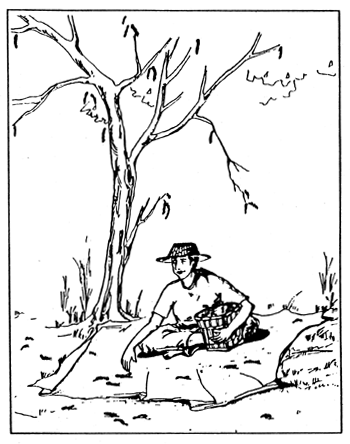
GCP/RAS/131/NET

 | REGIONAL WOOD ENERGY DEVELOPMENT PROGRAMME IN ASIA GCP/RAS/131/NET |  |
 | COLLECTION, STORAGE AND TREATMENT OF TREE SEEDS |
A HANDBOOK FOR SMALL FARM TREE PLANTERS

 | in collaboration with Save the Children /US, Thailand and |  |
| UNDP/FAO Regional Forest Tree Improvement Project | ||
This publication is printed by
the FAO Regional Wood Energy Development Programme in Asia,
Bangkok, Thailand.
| Illustrators: | Mr. Komrit Putarakhit, Miss Wipawadee Issawasopon & Mr. Chanwit Ponpukdee |
| Cover Photo: | Seed collection under neem tree |
| The designations employed and the presentation of material in this publication do not imply the expression of any opinion whatsoever on the part of the Food and Agriculture Organization of the United Nations concerning the legal status of any country, territory, city or area or of its authorities, or concerning the delimitation of its frontiers or boundaries. |
| The opinions expressed in this publication are those of the author alone and do not imply any opinion on the part of the FAO. |
| FOR THAI COPIES WRITE TO: | Agro- and Community Forestry Project Save the Children/US 124–126 Kosee Road Nakhon Sawan 60000, Thailand |
Farmers in Asia have become increasingly interested in planting trees on their farms, and on village public lands. The reasons for their growing interest are many, including:
One serious obstacle to improving farm and village wood supplies has been the difficulty of obtaining high quality seed from forest departments, or other seed distribution centers. But standing trees in the vicinity of local farms can provide a ready and excellent source of high quality seed for aspiring tree farmers. With knowledge of a few simple procedures, small farmers can become expert tree seed collectors and tree growers. Then, they need not depend upon anyone other than themselves to plant as many trees of the various types they desire.
That is why the FAO Regional Wood Energy Development Programme, and Save the Children/US Thailand in 1992 developed the Thai version of this booklet: Collection, Storage, and Treatment of Tree Seeds: A Handbook for Small Farm Tree Planters. It is a handbook for farmers, and village level facilitators working to improve farms and rural community environments throughout Asia. Users of this handbook will become familiar with a few simple techniques which will enable them to be successful seed collectors. They will then be able to:
This booklet, based largely on a similar one produced by The Kengo Agroforestry Project in Kenya, owes a great debt of thanks to Kengo's authors, Arsen Mbonye and Kihisa Kiambi, and editor, Elizabeth Obel. The adapted version for Asia was prepared by Mr. Songphol Kamnerdratana, and edited by Andrew Mittelman: Assistant Project Coordinator and Coordinator for Save the Children's Agro- and Community Forestry Project in Thailand.
Since the first print in January 1992 some 500 copies of the Thai version have been distributed and a Vietnamese version has also been produced. The present English version was prepared in response to considerable interest shown by English speaking foresters and rural development workers in these two countries as well as from other countries in the region. I acknowledge with thanks the financial and technical assistance by the UNDP/FAO Regional Tree Improvement Project. Within RWEDP, Mr Michael Jensen, Associate Professional Officer Agroforestry has been responsible for the final editing and production of the present English version.
It is hoped that this booklet will contribute to self reliance of Asian farmers in managing their own environment and stimulate government officials and development workers to produce versions of it in other local languages.
Egbert Pelinck
Chief Technical Adviser
FOOD AND AGRICULTURE ORGANIZATION OF THE UNITED NATIONS
Bangkok, August 1993
Hyperlinks to non-FAO Internet sites do not imply any official endorsement of or responsibility for the opinions, ideas, data or products presented at these locations, or guarantee the validity of the information provided. The sole purpose of links to non-FAO sites is to indicate further information available on related topics.
This electronic document has been scanned using optical character recognition (OCR) software. FAO declines all responsibility for any discrepancies that may exist between the present document and its original printed version.
2. HOW TO SELECT GOOD MOTHER TREES
4.1 Collecting from natural seed fall
4.3 Pruning off seed bearing branches
4.4 Throwing a rope with weighted end to break off seed bearing branches
4.5 Climbing trees to collect seed
4.6 Collecting seed from felled trees
5. HOW TO PREPARE SEED FOR STORAGE